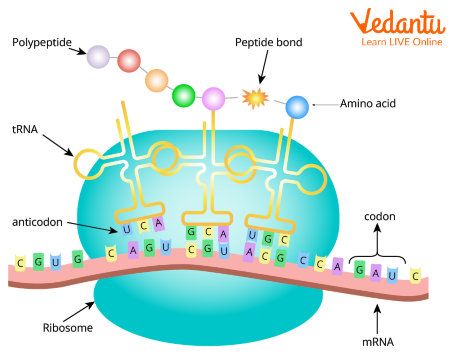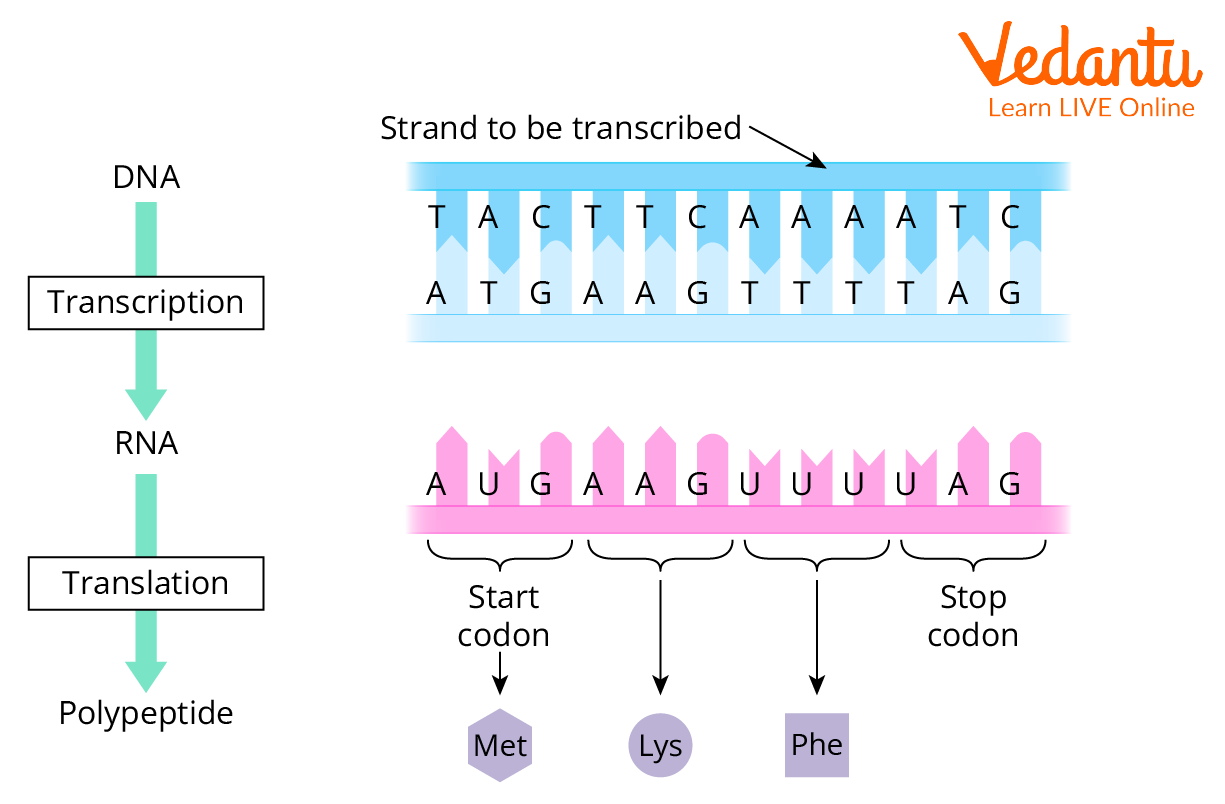Start Codon: A Sequence of Nucleotides
A codon is a three-letter gene sequence found in RNA and DNA. An example of a codon is the sequence AUG. There are three types of codons: start codons, stop codons, and normal codons. Each three-letter mRNA nucleotide sequence corresponds to a specific amino acid or stops codon. UGA, UAA, and UAG are stop codons. AUG is a methionine codon and a start codon.

Codon in Ribosome
Definition of Codon
A codon is a specific nucleotide sequence in an mRNA that corresponds to a specific amino acid or stop signal during protein translation. Nucleotides are then made up of nitrogenous base codons, a three-letter gene sequence found in RNA and DNA. An example of a codon is the sequence AUG. There are three types of codons: start codons, stop codons, and normal codons. Each three-letter mRNA nucleotide sequence corresponds to a specific amino acid or stops codon. UGA, UAA, and UAG are stop codons. AUG is a methionine codon and a start codon.es (or simply bases), sugars and phosphate groups.
How many nucleotides does a codon consist of? Now we can say that a sequence of 3 nucleotides constitutes a codon or a sequence of 3 nucleotides constitutes an mRNA codon. The major nitrogenous bases in RNA nucleotides are
Adenine (A)
Uracil (U)
Guanine (G)
Cytosine (C)
Therefore, a representative example of the genetic code is the triplet code. B. Codes for specific amino acids, including adenine-uracil-guanine (AUG), uracil-cytosine-cytosine (UCC), and uracil-guanine-adenine (UGA). A codon is the smallest unit of the genetic code because the set of codons in mRNA makes up the genetic code.
Simply put, each codon actually encodes a specific amino acid. It is also possible to encode signals that stop or start intracellular protein synthesis processes.
Start Codons and Stop Codons
Start Codon
The AUG codon is called the start codon. This is the first codon to be translated into the transcribed mRNA. AUG is the most common start codon and code for the eukaryotic amino acid methionine (Met) and prokaryotes formylmethionine (fMet). During protein synthesis, tRNA recognizes the AUG start codon through several initiation factors and initiates the translation of mRNA.
Some alternative start codons are found in both eukaryotes and prokaryotes. The replacement codon normally codes for an amino acid other than methionine, but acts as a start codon and uses a separate start tRNA to encode Met.
Stop Codons
There are three stop codons in the genetic code: UAG, UAA, and UGA. This codon marks the end of the polypeptide chain during translation. Because this codon does not code for an amino acid, it is also known as a nonsense codon or stop codon. The three stop codons were named amber (UAG), opal or amber (UGA), and other (UAA).
During protein synthesis, a stop codon triggers the release of a new polypeptide chain from the ribosome. This is because the tRNA does not have an anticodon complementary to the stop codon.

Start and Stop Codon
Difference between Start and Stop Codons
The difference between the two codons are as follows:
Interesting Facts
Discovery of Start Codon
In 1964 Nirenberg and Philip Leder, a postdoctoral fellow at National Institutes of Health, discovered some way to work out the sequence of the letters in every triplet word for amino acids. By 1966 Nirenberg had deciphered the sixty four ribonucleic acid three-letter code words (codons) for all twenty amino acids.
Important Questions
1. What are the salient features of the genetic code?
Ans: This is a triplet with 61 codons coding for amino acids and 3 codons not coding. So they act as stop codons.
Codons are unambiguous and specific because they code for only one amino acid.
Codons are read sequentially from the mRNA. There are no punctuation marks.
Some amino acids are encoded by multiple codons, which degenerates the encoding.
The code is almost universal. From bacteria to humans, for example, UUUs encode phenylalanine (Phe). Some exceptions are found in mitochondrial codons and some protozoa.
AUG has two functions. It codes for methionine (Met) and also functions as a start codon.
2. Given below are the sequence of nucleoside in a particular mRNA and amino acids coded by it UUUAUGUU CGAGUUAGUGUAA Phe – Met – Phe – Glu – Leu – Val. Write the properties of genetic codes that can be and that cannot be correlated from the above-given data.
Ans: UUUAUGUUCGAGUUAGUGUAA Phe-Met-Phe-Glu-Leu-Val According to the above sequence:
The codon is a triplet.
The genetic code is specific and clear. For example, the code AUG-methionine (Met) code.
GAG-glutamine (Glu) code UUA-leucine (Leu) is degenerate.
The same amino acid is encoded by multiple codes. For example, UUU and UUC are the codes for phenylalanine (Phe).
Code is read without punctuation.
Thus, all properties of the codon are satisfied from the above-given data. Except for the one that mostly AUG works as an initiating codon.
Practice Questions
Mention the role of the codons AUG and UGA during protein synthesis.
Mention the contribution of genetic maps in the human genome project.
What is the function of Codon AUG?
Answers
AUG Acts as an initiation codon and codes for amino acid methionine. UGA Acts as a stop/termination codon that signals the termination of polypeptide synthesis.
Genetic maps are used as a starting point in the sequencing of whole genomes.
Codes for methionine and is the starting point of protein synthesis (initiation codon).
Key Features
The genetic code has two punctuation marks: the start codon and the stop codon
Codons in all organisms indicate the end of protein synthesis.
The start codon indicates the point at which translation into the protein sequence begins.
The stop codon indicates the point at which translation ends.


FAQs on Start Codons in DNA and RNA
1. What does the Codon Sequence Look Like?
A sequence contains a lot of information such as N-terminus and C-terminus. The mRNA is interpreted by the cell by interpreting this codon. H. Group of 3 nucleotides. Four RNA nucleotides can inhibit three possible combinations. Of the 64 codon groups, 62 define amino acids, and the remaining 3 (UAA, UAG, or UGA) act as stop signals. This group represents the end of protein synthesis. There is another AUG codon with a unique function. This serves as a starting signal for initiating translation.
2. What is a stop codon and what are its functions?
The stop codon is the codon that codes for the stoppage of protein synthesis. That is the production of new proteins should stop. There are 3 STOP codons in the genetic code - UAG, UAA, and UGA. These codons signal the end of the polypeptide chain during translation. These codons are also known as nonsense codons or termination codons as they do not code for an amino acid. A stop codon is a genetic code that signals the end of protein manufacturing inside the cell, like a period at the end of a sentence.
3. Explain the role of the regulatory gene in a lac operon Why is the regulation of lac operon called negative regulation?
The lac operon consists of one regulatory gene and three structural genes (z, y, and a)T the I gene codes for the repressor of the lac. If repressor protein binds to the operator region of the operon, it prevents RNA polymerase from transcribing the operon. Whereas, in presence of lactose (inducer) the repressor becomes inactivated due to interaction with the inducer. This allows RNA polymerase access to promoter and transcription proceeds. Regulation of lac operon is negative. Regulation of lac operon by a repressor is referred to as negative regulation.










